
The Cthulhu Mythos is a mythopoeia and a shared fictional universe, originating in the works of American horror writer H. P. Lovecraft. The term was coined by August Derleth, a contemporary correspondent and protégé of Lovecraft, to identify the settings, tropes, and lore that were employed by Lovecraft and his literary successors. The name "Cthulhu" derives from the central creature in Lovecraft's seminal short story "The Call of Cthulhu", first published in the pulp magazine Weird Tales in 1928.

Howard Phillips Lovecraft was an American writer of weird, science, fantasy, and horror fiction. He is best known for his creation of the Cthulhu Mythos.
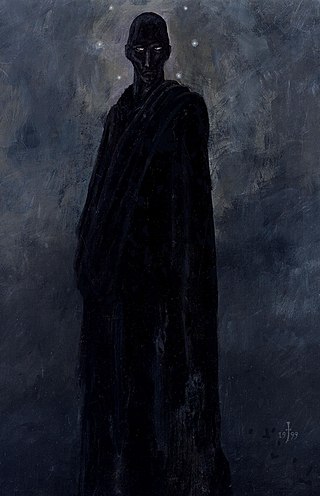
Nyarlathotep is a fictional character created by H. P. Lovecraft. The character is a malign deity in the Cthulhu Mythos, a shared universe. First appearing in Lovecraft's 1920 prose poem "Nyarlathotep", he was later mentioned in other works by Lovecraft and by other writers. Later, writers describe him as one of the Outer Gods, an alien pantheon.
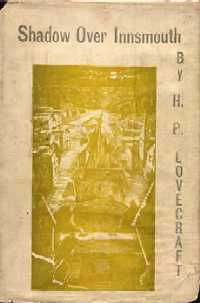
The Shadow over Innsmouth is a horror novella by American author H. P. Lovecraft, written in November–December 1931. It forms part of the Cthulhu Mythos, using its motif of a malign undersea civilization, and references several shared elements of the Mythos, including place-names, mythical creatures, and invocations. The Shadow over Innsmouth is the only Lovecraft story that was published in book form during his lifetime.
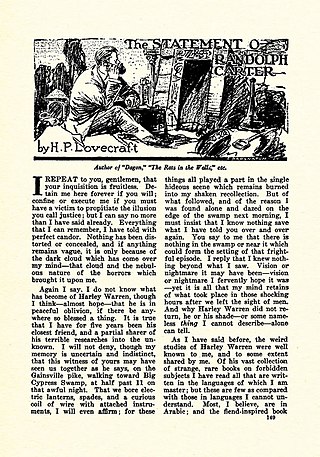
"The Statement of Randolph Carter" is a short story by American writer H. P. Lovecraft. Written in December 1919, it was first published in The Vagrant, May 1920. It tells of a traumatic event in the life of Randolph Carter, a student of the occult loosely representing Lovecraft himself. It is the first story in which Carter appears. Its adaptations include the film The Unnamable II: The Statement of Randolph Carter.

"The Outsider" is a short story by American horror writer H. P. Lovecraft. Written between March and August 1921, it was first published in Weird Tales, April 1926. In this work, a mysterious individual who has been living alone in a castle for as long as he can remember decides to break free in search of human contact and light. "The Outsider" is one of Lovecraft's most commonly reprinted works and is also one of the most popular stories ever to be published in Weird Tales.

The Shadow Out of Time is a novella by American horror fiction writer H. P. Lovecraft. Written between November 1934 and February 1935, it was first published in the June 1936 issue of Astounding Stories. The story describes time and space travel by mind transfer, where a person in a given place and time can switch bodies with someone who is elsewhere or elsewhen. As with other Lovecraftian works, this story features otherworldly alien beings that are not simply variations on humans or other familiar terrestrial animals.

"Dagon" is a short story by American author H. P. Lovecraft. It was written in July 1917 and is one of the first stories that Lovecraft wrote as an adult. It was first published in the November 1919 edition of The Vagrant. Dagon was later published in Weird Tales in October 1923. It is considered by many to be one of Lovecraft's most forward-looking stories.
"The Unnamable" is a horror short story by American author H. P. Lovecraft. It was written in September 1923, first published in the July 1925 issue of Weird Tales, and first collected in Beyond the Wall of Sleep. The corrected text appears in Dagon and Other Macabre Tales,. The story's locale was inspired by the Charter Street Historic District Burying Ground in Salem.

"From Beyond" is a horror genre short story by American writer H. P. Lovecraft. It was written in 1920 and was first published in The Fantasy Fan in June 1934.
"Polaris" is a fantasy short story by American author H. P. Lovecraft, written in 1918 and first published in the December 1920 issue of the amateur journal The Philosopher. It is the story that introduces Lovecraft's fictional Pnakotic Manuscripts, the first of his arcane tomes.
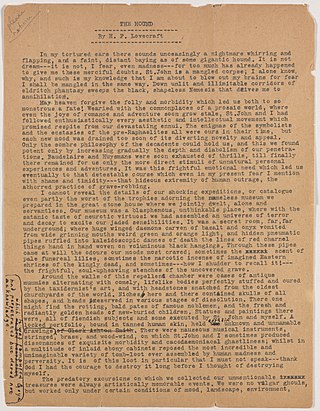
"The Hound" is a short story written by H. P. Lovecraft in September 1922 and published in the February 1924 issue of Weird Tales. It contains the first mention of Lovecraft's fictional text the Necronomicon.

"The Thing on the Doorstep" is a horror short story by American writer H. P. Lovecraft, part of the Cthulhu Mythos universe. It was written in August 1933 and first published in the January 1937 issue of Weird Tales.
"The Picture in the House" is a short story written by H. P. Lovecraft. It was written on December 12, 1920, and first published in the July issue of The National Amateur—which was published in the summer of 1921. It was reprinted in Weird Tales in 1923 and again in 1937.

"Nyarlathotep" is a prose poem by H. P. Lovecraft. It was written in 1920 and first saw publication in that year's November issue of The United Amateur. The poem itself is a bleak view of human civilization in decline, and it explores the mixed sensations of desperation and defiance in a dying society.
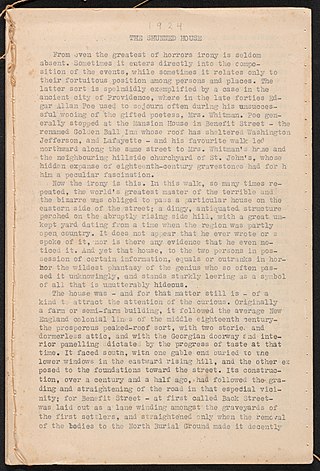
"The Shunned House" is a horror fiction novelette by American author H. P. Lovecraft, written on October 16–19, 1924. It was first published in the October 1937 issue of Weird Tales.

"He" is a short story by American horror writer H. P. Lovecraft. Written August 1925, it was first published in Weird Tales, September 1926.

"Herbert West–Reanimator" is a horror short story by American writer H. P. Lovecraft. It was written between October 1921 and June 1922. It was first serialized in February through July 1922 in the amateur publication Home Brew. The story was the basis of the 1985 horror film Re-Animator and its sequels, in addition to numerous other adaptations in various media.
Harley Warren is a fictional character created by H. P. Lovecraft, based on his friend Samuel Loveman (1887–1976). Lovecraft had a dream about Loveman, which inspired him to write the short story "The Statement of Randolph Carter" in 1919. In the story, Warren is a mysterious occultist and friend of Carter, who suffers a gruesome but undefined fate while exploring a crypt in Big Cypress Swamp.

Samuel E. Loveman was an American poet, critic, and dramatist probably best known for his connections with writers H. P. Lovecraft and Hart Crane.
















